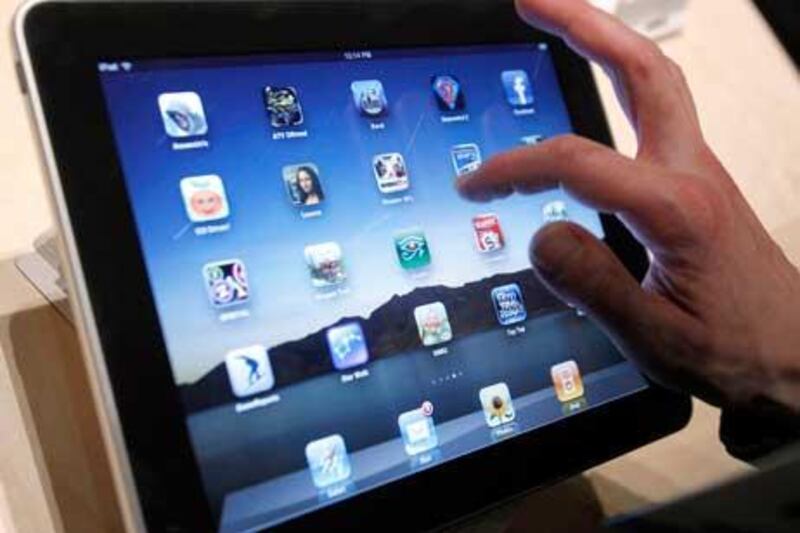Business moguls such as Rupert Murdoch and Sir Richard Branson are developing newspapers and magazines that can be viewed only online on the Apple iPad. This move to entirely digital newspaper publishing could herald a global expansion of online publishing in regions such as the Middle East, which have a growing thirst for local content.
Mr Murdoch, the chairman of News Corp, is reported to be planning a daily digital iNewspaper to launch on the iPad, which it is understood will be called The Daily. He is believed to have a staff of 100 in place in New York to run the newspaper. The absence of printing costs means The Daily is expected to retail at only 99 cents a week. The project follows Mr Murdoch's move to make the digital versions of the UK's The Times and The Sunday Times pay-only websites.
But The Daily has already attracted criticism from rivals who say that a staff of 100 is too small to produce a credible daily newspaper. However, some of Mr Murdoch's rivals, such as Sir Richard, are trying to leapfrog News Corp by publishing offerings of their own, with Virgin expected to unveil an iPad magazine in New York this week.
Newspaper publishers are becoming convinced that iNewspapers on devices such as the iPad will gradually come to replace print. Many of the world's leading publications are also developing versions of their publications specifically for the iPad. The Economist, for example, has an iPad application and, like other digital publishers, considers these new internet devices as ideal for winning market share in regions such as the Middle East, where print distribution can be expensive.
Sanjay Gohil, the iPad production editor at the Financial Times, says: "The iPad is a lot more nimble and quick than traditional PCs and allows you to download electronic newspapers and read them later, when you are without an internet connection."
He says the iPad allows online newspapers to become multimedia products, offering video and audio clips in addition to print and stills photography.
But the publishing industry is having to conduct a balancing act between older readers who still read newspapers and generally younger readers, who expect instant information via the web.
"We are faced with a crossroads with a younger generation used to electronic media and an older generation that remains loyal to print," says Mr Gohil.
This could be a difficult balancing act for the traditional newspaper industry to maintain profitably. Although the Financial Times has developed an iPad version, its cost base is still mired in heavy overheads and printing costs.
Mr Murdoch believes there is room for digital newspapers that can be produced at a fraction of the cost of printed ones. Given his history of commercial success in establishing top-selling mass circulation tabloid newspapers such as The Sun in the UK, he may well be able to launch an equally compelling product for the iPad. But some in the industry believe his newspaper editorial costs may not be as low as might be expected.
"If Mr Murdoch has only 100 staff, that is a very small team to produce a daily," says Mr Gohil. "If, however, he intends to aggregate content from the rest of the group, a team that size would be more than adequate."
It is also likely that Sir Richard will wish to use other parts of the Virgin group to provide support for his new magazine in the US.
The underlying reason that media moguls are drawn to the iPad and the iPhone is that users are happy to pay for certain applications and content. This is not usually the case with PC websurfers, who tend to shy away from "paywalls" that demand credit card details.
Some analysts believe the iPad, and the devices that will follow it, will play an increasingly crucial and central role in many publishers' strategies.
"The Splinternet, Forrester's term for the proliferation of platforms and devices, has a new addition: Apple's iPad," says Sarah Rotman Epps, an analyst at the research company Forrester. "Even though the iPad's current install base pales in comparison to other platforms, the enthusiasm that surrounds it, along with its unique product development opportunities, prompts product strategists to bump it to the top of their priority lists.
"The iPad is just the first of many devices that fall on a continuum between small mobile phones and larger netbooks, laptops, and stationary PCs. Companies like HP, Lenovo, and Samsung have all promised multimedia slates, with prototypes ranging from 7 to 10 inches.
"As a portable device, convenience is one of the main benefits of the iPad - it makes accessing products and services through the device more convenient."
According to the Gartner report Hype Cycle for Media Industry Publishing, 2010, the tablet's ability to showcase books, newspapers and magazines together with live video and TV on demand will allow it to replace a number of existing devices.
Publishers are convinced the iPad offers a gateway to charge readers hard cash or to generate hefty ad revenues for iNewspapers and iMagazines. But this new media territory is still up for grabs.
Traditional newspapers with cost-heavy printing processes will increasingly be challenged by iNewspapers on devices such as the iPad. Both are likely to be judged by the extent to which they can use exclusive news coverage to differentiate their content from the sea of news and features already freely available on the web.
All iNewspapers will also soon start to rely increasingly on video content that will make their internet publications look even less like traditional print publications and more like multimedia websites. Users may soon start to see them less as online newspapers, bringing them into direct competition with TV and news websites now proliferating across the web.





